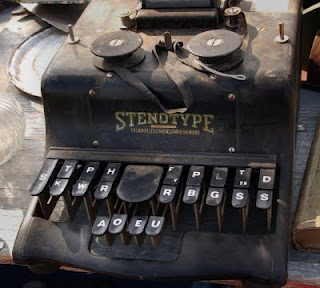 This is the 5th installment of an on-going series about my experience training to be a court reporter.
This is the 5th installment of an on-going series about my experience training to be a court reporter.
There is a long and interesting history of written and machine shorthand. There is even a permanent exhibition, The Gallery of Shorthand: The Evolution of a Timeless Profession, in the Alfonse M. D’Amato Federal Courthouse in Central Islip, Long Island.
Now that sounds like a very worthwhile excursion, doesn’t it?
In lieu of making the trek out to the Richard Meier designed Islip courthouse, I was able to gather quite a few nifty historical tidbits from their interesting website.
In Ancient Rome there were scribes, individuals responsible for transcribing minutes of the Roman Senate. Before 63 BC they wrote from memory and these transcripts were sometimes published.
In 63 BC, Cicero, the great orator of Rome, developed Tironian Notes, the very first system of short writing. To save time, this system used letters to represent common words, and left out letters, usually vowels, that weren’t necessary. Sometimes initials or other parts of several words were joined. Speed was achieved by rarely removing the hand from the wax tablet.
In 59 BC, Emperor Julius Caesar sought to eliminate the secrecy of Senate deliberations, and ordered that they be recorded using Tironian Notes.
Hail Ceasar.
Apparently some Tironean Shorthand is still used in contemporary shorthand such as abbreviating by using only the first letters of common phrases (am, pm, USA).
During the middle ages, shorthand was outlawed because it was viewed as crytography or secret writing, and therefore inherently evil. Despite the prohibition, monks were allowed to use shorthand to write. And that’s a good thing. Much of what we know about the intellectual and religious history of that time we know form these shorthand writing monks.
But I digress. Machine shorthand, as taught at the New York Career Institute, is what we are interested in here.
We have Miles M. Bartholemew to thank for the invention of the first English-language stenography machine in 1879. That precursor to today’s steno machine utilized dot/dash codes to form one letter at a time. It makes me think of Morse Code. 150 words per minute was the top speed you could reach on this machine. Apparently vowels were eliminated and words were written as phonetic abbreviations.
In 1866, George Kerr Anderson designed the first word-at-a-stroke shorthand machine called. The Anderson Shorthand Typewriter. It used printed letters instead of codes and was capable of fast writing speeds.
In 1911, the Ireland Stenotype Shorthand Machine was invented by Ward Stone Ireland. This steno innovator spent six years analyzing the arrangement of letters and sounds in the English language. He’s responsible for the chorded method and the ” two-row, tripartite key arrangement of initial consonants, final consonants, and middle vowels” that those of us who have studied Steno know and love. This groundbreaking system allowed” the greatest output with the fewest strokes.”
Indeed, that is the essence of steno: the greatest output with the fewest strokes. Make THAT your mantra.
